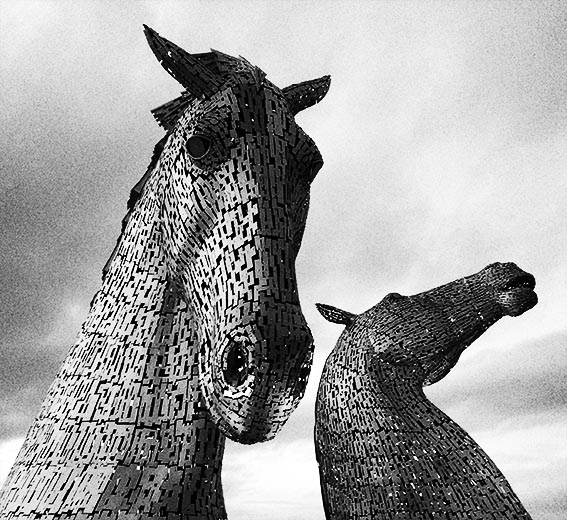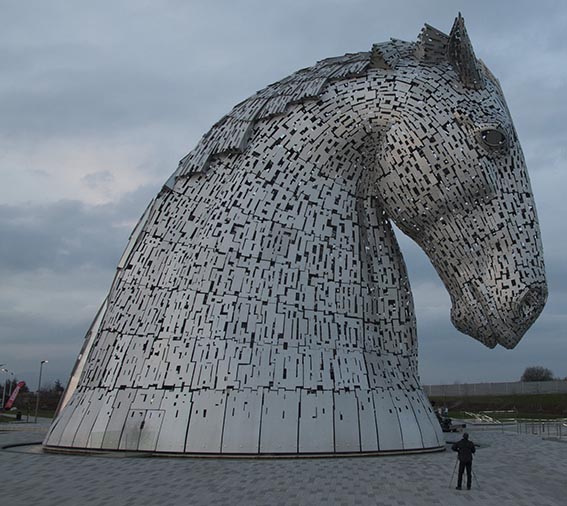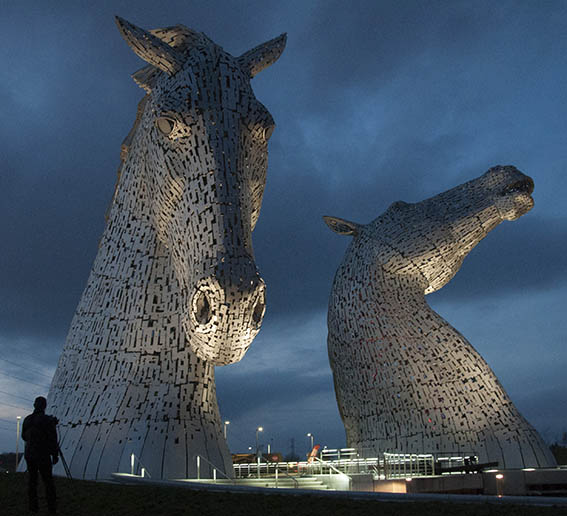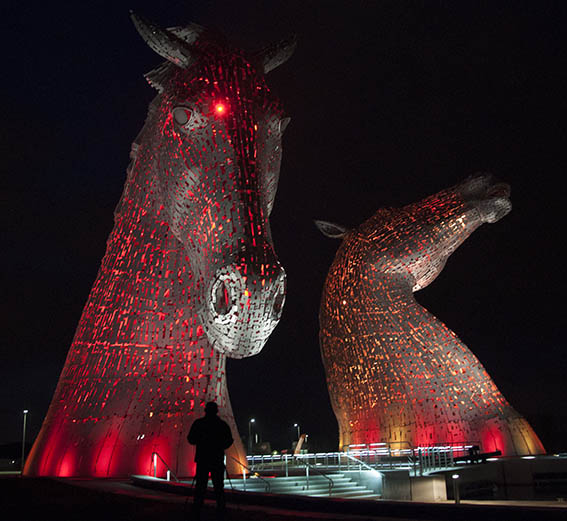We ran a 2 day private landscape photography course in Northumberland at the weekend, a drive of about 4.5 hours from home in the Peak District. Falkirk was about another hour or so further north so we decided, having driven this far, to drive the extra distance to take photos of the Kelpies sculptures, by Andy Scott, near Falkirk. They have been on my shooting list since being asked for prints of them several times at a show we did in Glasgow at the end of last year. They were only installed in April last year and they are still building the visitor centre to go with them. The 2 horse heads are the worlds largest equine sculptures at 30m high and they are surrounded by water. Walking around them you feel quite small!
The sculptures are made of small metal plates with gaps between each plate. Some areas have large solid metal plates, for example, the mane of each horse head and the plates at the base, which include doors to access the inside of both sculptures (they run tours inside the sculptures).
We arrived about 6.30pm on 22nd March as the light was fading, the sun had just gone down. It was cold! The metal of the sculptures was catching just a few bits of light and the clouds were different shades of grey so I had lots to work with, not great for Jan’s colour shots but good for my black and white ones.
I continued taking shots as it went dark over the following hour. There were some small lights turned on around the footpaths just before we arrived, after sunset as the light faded. Then the floodlights came on at 6.40pm. It was too light to notice them to start with but their effect increased as it went darker. I took lots of photos with the white floodlights. Exposure times were mostly 30 seconds to 1 minute at f5.6.
My Sekonic spot meter gave me the exposure times up to 15 seconds at f5.6. After this I guessed at the exposure to use. (Note, having returned home and processed the films all of my exposures were good.)
We had to wait over an hour for the final piece of lighting to come on at about 7.40pm, this was an hour after the white floodlights came on. Inside each sculpture red lights were turned on as well as red floodlights for the base of both sculptures. These made them look spectacular! Exposure times for my Ilford FP4 were now up to 2 minutes at f5.6 so I just did 4 exposures of 3 different compositions to finish. It will be interesting to see which lighting set works best in black and white, the white floodlights or the red internal lights. My final shot was of both sculptures with some wind-blurred reflections in the pool of water in front of them. In total I ran off 3 rolls of 120 FP4 film, that’s 30 exposures.
It was interesting to see 4 photographers already there when we arrived. 1 quickly disappeared leaving 3. They stayed for about 30 minutes to take the white floodlights then they all left. Jan and I were the only ones left by the time the red lights were turned on and mostly had the place to ourselves for the final 30 minutes, we left at about 8.15pm.
The place is surrounded by a raised motorway on one side and electricity pylons and cables on the other. There’s also a canal system that actually goes between the 2 sculptures with lock gates. Taking shots without cables and pylons was difficult and will need judicious cropping of my final images, which I took into account before pressing the button. The shot from directly in front of the 2 heads with a pool of water in front, that 2 of the photographers staked out, really only works after it goes properly dark as this hides the cables. They left before the red light phase which would have given them the most spectacular colour shots, but they had been there before so hopefully had taken it previously.
Kelpies in Black and White, taken on my phone from the same position as used for the proper photos taken with my Mamiya 7 film camera.

Jan took photos too and I have included 3 here to show the different lighting that we had. I’m also in the foreground of all of them for a bit of scale! Jan took all of her shots handheld and used 3200 ISO for the night shots and 1600 and 3200 ISO for the white floodlights phase. ISO 800 was enough for the dusk shots. This gave exposure times of 1/30 to 1/10 sec. With the built in vibration reduction system of the Nikon D90 the shots are sharp and will make good A3 prints!
Kelpies after Sunset

Kelpies at Dusk

Kelpies at Night





